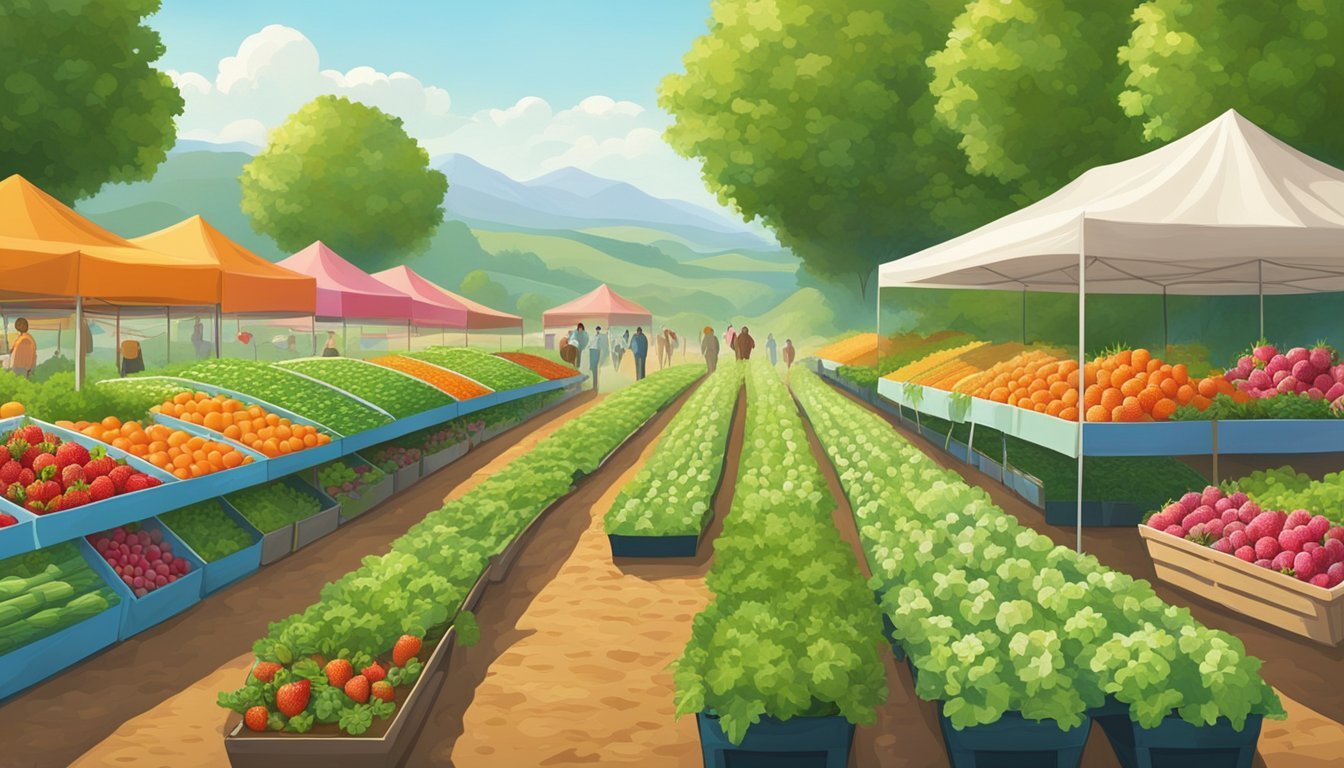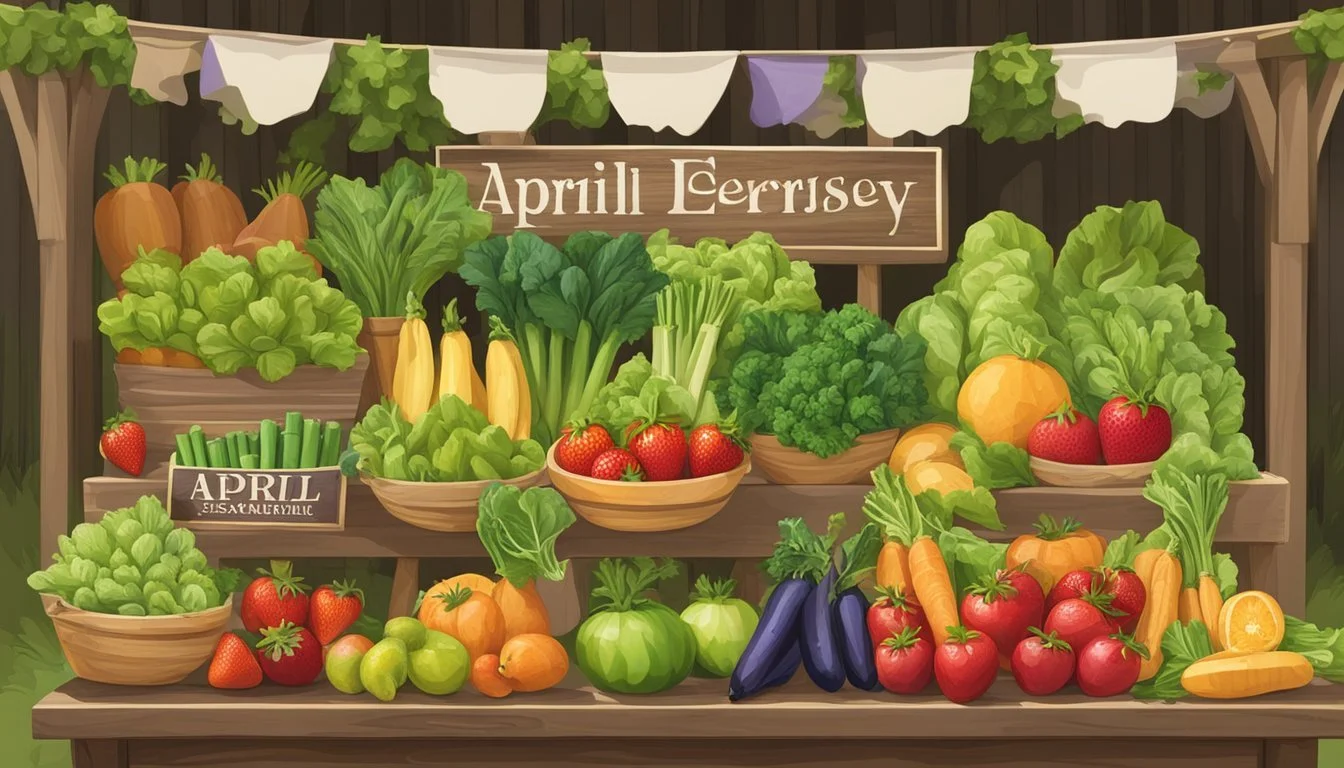New Jersey Seasonal Fruit & Vegetables in April
A Guide to Fresh Produce
This Article is Part of our New Jersey Seasonal Fruit & Veg Calendar
As the calendar turns to April, New Jersey's agricultural offerings begin a period of transformation, signaling the arrival of spring's freshest flavors. Although April in New Jersey is generally not the peak season for a wide variety of fruits and vegetables, it marks the beginning of the growing season for some key produce items. The state's fertile lands start to yield crops that are favored in spring menus, and local markets begin to showcase the early bounties of the region.
During this time, connoisseurs of garden-fresh produce eagerly await the emergence of certain fruits and vegetables that are best enjoyed during their natural harvest period. In New Jersey, April may not boast the abundance of the summer months, but it does bring its particular set of crops. For instance, asparagus (What wine goes well with asparagus?), recognized for its tender and flavorful spears, starts to appear, becoming one of the first green vegetables to signal the end of winter's scarcity.
New Jersey's cool April temperatures also make it a prime time for the last harvests of overwintered crops like spinach and the hearty greens; these are often at their most tender and sweet after a cold season. While fruit offerings remain sparse, the groundwork laid in April ensures a diverse and rich production in the months following, as the state's well-known tomatoes, blueberries, and other summer staples will soon ripen under the warming sun. Thus, April stands as a month of anticipation, where the seeds sown yield the earliest returns and the promise of a flavorful summer to come.
Overview of New Jersey's Seasonal Calendar
New Jersey's climate offers fertile ground for an array of fruits and vegetables throughout the year, each flourishing in its respective season. The state's agricultural calendar is partitioned into the distinct seasons of spring, summer, fall, and winter, guiding what is best to plant, grow, and harvest.
Understanding New Jersey's Growing Seasons
New Jersey's growing seasons are largely influenced by its temperate climate. Spring sets in around March, marking a transition from the cold winter months. This season is pivotal for planting many early vegetables and welcoming the first harvests of the year. As the state moves into the warmer summer months, a wider variety of crops bask in the peak growing conditions. Fall brings a cooler atmosphere, ideal for certain late-season produce, while winter generally slows down the growing cycle, making it the offseason for most crops but still suitable for some hardier varieties.
April's Position in the Agricultural Calendar
April in New Jersey is an integral month nestled within the spring season. It's a time when farmers prepare soil and begin planting, while also harvesting early-spring crops. While it leads up to the warmer and busier summer months of bountiful produce, April's usually mild temperatures allow certain cool-weather crops to thrive before the state enters the full swing of the summer harvest season.
Spring Vegetables and Fruits in April
April marks the start of spring's bounty in New Jersey, where a variety of fresh produce begins to emerge. The focus is on leafy greens and hearty vegetables that thrive in the cool, damp weather of early spring.
Leafy Greens Availability
Lettuce: Varieties such as green leaf, red leaf, and romaine are plentiful.
Spinach: Offers tender, vibrant leaves perfect for salads.
They are available in abundance, providing fresh options for salads and side dishes.
Cruciferous Vegetables and Roots
Broccoli: Starts becoming available and is known for its rich, green florets.
Cauliflower: Can also start to appear in markets, with its tight, white clusters.
Other vegetables such as radishes and turnips offer crisp textures and peppery flavors. These root vegetables are ideal for roasting or adding to salads for a burst of freshness. Asparagus, a springtime favorite, begins to make its appearance, celebrated for its versatility and delicate flavor. Garden peas, particularly sugar snap and snow peas, are found in April—sweet and crunchy, they are perfect for eating raw or lightly steamed.
April's Seasonal Fruit Selection
April in New Jersey brings the early harbingers of spring produce to the market. The selection includes a variety of fruits that are not only fresh but an excellent addition to the diet after the cold winter months.
Early Berries and Stone Fruits
Rhubarb: Although technically a vegetable, rhubarb is commonly treated as a fruit in culinary practices. It's one of the first plants to be harvested in April. Its tart flavor makes it ideal for pies and desserts.
Strawberries: These popular berries start to make their appearance in late April, signaling the start of the berry season in New Jersey. They are juicy and full of flavor, perfect for eating fresh or incorporating into recipes.
The Importance of Freshness and Locality
In New Jersey, the freshness and locality of produce are paramount, especially as April showcases the seasonal transition. Consumers are presented with a compelling choice between local produce and supermarket varieties, each with its own set of benefits tied to flavor and freshness.
Local Produce Vs. Supermarket Varieties
Local Produce in New Jersey:
Flavor: They reap the full benefits of being picked at peak ripeness, leading to a better flavor profile.
Freshness: Reduced time from farm to table means nutrients and textures are preserved.
Supermarket Varieties:
Often harvested before peak ripeness to survive long transport durations, which can compromise flavor.
Extended shelf life may result in diminished freshness and nutrient content.
Benefits of Eating Seasonally
April's Bounty:
Jersey Tomatoes: Known for their superior flavor, though they start appearing later in the season.
Other Local Offerings: Root vegetables and cold-hardy greens may still be found from local producers during this month.
Advantages of Seasonal Eating:
Encourages a diverse diet enriched with a variety of nutrients.
Supports local farms, bolstering the regional economy and sustainability.
Seasonal Recipes and Preparation Ideas
In April, the focus on seasonal eating in New Jersey brings fresh tastes to the table through vibrant salads and sides, as well as delightful desserts and preserves. The recipes below take advantage of the produce like asparagus, strawberries, and other fresh fruits and vegetables, integrating the season's bounty into every bite.
Spring Salads and Sides
Asparagus: A hallmark of spring, asparagus can be simply grilled or roasted with a touch of olive oil, salt, and pepper to bring out its natural flavors. Alternatively, a refreshing asparagus salad can be assembled with mixed greens, goat cheese, sliced almonds, and a lemon vinaigrette.
Ingredients for Asparagus Salad:
Fresh asparagus, trimmed and blanched
Mixed salad greens
Goat cheese, crumbled
Sliced almonds, toasted
Olive oil
Fresh lemon juice
Salt and pepper to taste
Herbs: Fresh herbs like parsley, chives (how long do chives last?), and dill (how long does dill last?) are abundantly available and can enhance the flavor of both salads and cooked vegetables (how long do cooked vegetables last?). They can be finely chopped and sprinkled over dishes for a burst of brightness.
Desserts and Preserves with April Produce
Strawberries and Berries: With a natural sweetness, strawberries and other berries become ripe in April and are perfect for jams, jellies, or a simple, rustic strawberry cobbler. Their freshness complements both creamy and baked desserts, pairing well with creams and pastries alike.
Strawberry Cobbler:
Fresh strawberries, hulled and halved
Granulated sugar
All-purpose flour
Baking powder
Salt
Unsalted butter, melted
Milk
Vanilla extract
Preheat the oven, combine strawberries with sugar, and let sit. Whisk together dry ingredients; mix in melted butter, milk, and vanilla. Pour over the sugared berries in a baking dish and bake until the topping is golden.
Preserves: Preserving fruits like strawberries can extend the enjoyment of April's harvest throughout the year. Homemade strawberry jam, for example, can be made with just fresh fruit, sugar, and a bit of lemon juice, capturing the essence of spring in a jar.
Where to Find April's Seasonal Produce
In April, those seeking fresh, local produce in New Jersey may wonder where to turn as the growing season picks up pace. Various venues offer access to April’s bounty, with some even providing the rewarding experience of harvesting your own fruits and vegetables.
New Jersey Farmers' Markets
Farmers' markets are prime destinations for a variety of April produce. These markets have a direct relationship with local farms, ensuring that the fruits and vegetables offered are among the freshest available. Shoppers can find a selection of early spring produce, and can typically ask the farmers directly about their growing practices and upcoming harvests.
Examples of Farmers' Markets:
Montclair Farmers' Market: Offers a wide range of seasonal vegetables and fruits sourced from local producers.
Trenton Farmers' Market: A historic marketplace with a diverse array of New Jersey-grown produce.
U-Pick Farms and Orchards
For those who prefer the hands-on approach, several U-Pick farms and orchards open their gates in April for the public to pick their own. It is advisable to call ahead or check the farm’s website for up-to-date information on picking conditions and produce availability.
Examples of U-Pick Farms:
Alstede Farms: Allows visitors to pick their own seasonal products, which may include early berries or greens depending on the year's growth.
Demarest Farms: Known for apple picking in the fall, may begin to offer other picking opportunities as the season progresses.
Gardening Tips for the Season
In New Jersey, April marks a pivotal month in gardening, providing a window of opportunity to set the stage for a fruitful harvest. The right strategies meshed with a good understanding of the state's early spring conditions can ensure a bountiful yield.
Planting Strategies for New Jersey Climatic Conditions
New Jersey's climate in April is characterized by warming temperatures that make it suitable for starting various vegetables. One should monitor night temperatures, ensuring they consistently stay above 50 degrees before transplanting vegetables such as tomatoes and peppers. These conditions are typical as May approaches, marking a period when soil begins to warm, catering to the needs of both seeds and transplants.
A gardener should utilize a calendar to track planting dates and thrive on the state's zonal differences:
Zones 6 and 7: Ideal for cool-season crops
May: Transition to warmer-season vegetables
April Gardening Do's and Don'ts
Do:
Start seeds indoors for warm-season vegetables to get a jump on the growing season.
Direct sow cool-season crops like lettuce, spinach, and peas, which can tolerate the cooler soil temperatures.
Don't:
Plant tender crops outdoors until the threat of frost has passed, which is typically by mid to late May.
Neglect pest management; for example, slugs may target young shoots, so proactive monitoring is crucial.
For optimal results, one should always integrate the farm's specific conditions with general guidelines. Managing a garden requires keen observation and swift action to protect the plants from pests and frost while providing a nurturing environment for growth.
Anticipating the Arrival of Summer Produce
As April awakens the soil in New Jersey, gardeners and farmers prepare for the summer bounty. This time of year sets the stage for the arrival of some of the state's most eagerly awaited produce.
What to Expect in Upcoming Months
Berries: Come June, New Jersey's berry patches will come alive, particularly with blueberries. These berries are expected to be at their peak, juicy and ready for harvest, through August.
Corn: Sweet corn, one of the staples of summer barbecues, will start its season in the warm days of summer. New Jersey's corn is known for its sweet, plump kernels and is a highlight at many local markets.
Tomatoes: New Jersey is famous for its tomatoes, often hailed for their flavor and quality. The tomato season generally begins in earnest in June and lasts through the warm summer months, with various varieties available.
Expected Summer Produce:
June to August:
Berries (especially blueberries)
Sweet Corn
Tomatoes
Farmers' markets and local produce stands will soon be showcasing these items, signaling the transition from spring greens to the more robust flavors of summer.







